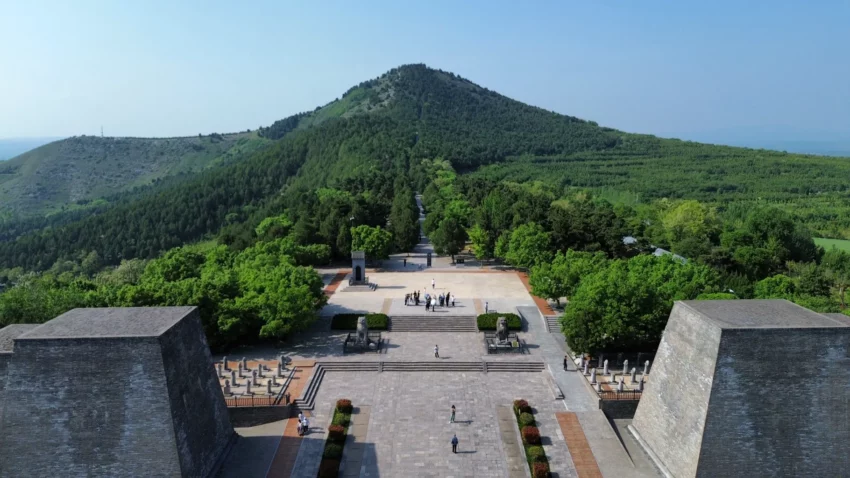Overview of the Qianling Mausoleum
The Qianling Mausoleum, a significant historical site, serves as the joint tomb of Emperor Gaozong of Tang, Li Zhi (628-683 AD), and Empress Wu Zetian (624-705 AD). This mausoleum is situated approximately 6 km north of Qian County in Shaanxi Province, on Mount Liangshan.
Get your dose of History via Email
Geographical and Architectural Significance
Mount Liangshan, where the mausoleum rests, features three limestone peaks. The northern peak, the tallest at 1047.9 meters, presents a majestic and imposing figure. The mausoleum’s appearance changes depending on the viewer’s perspective. From the east, it resembles a “Sleeping Beauty,” with the north peak representing her head and the south peaks her breasts. From the west, it takes on the appearance of a stately, sleeping lion. This site was chosen by skilled geomancers of the Tang Dynasty for its unique and advantageous geographical features.
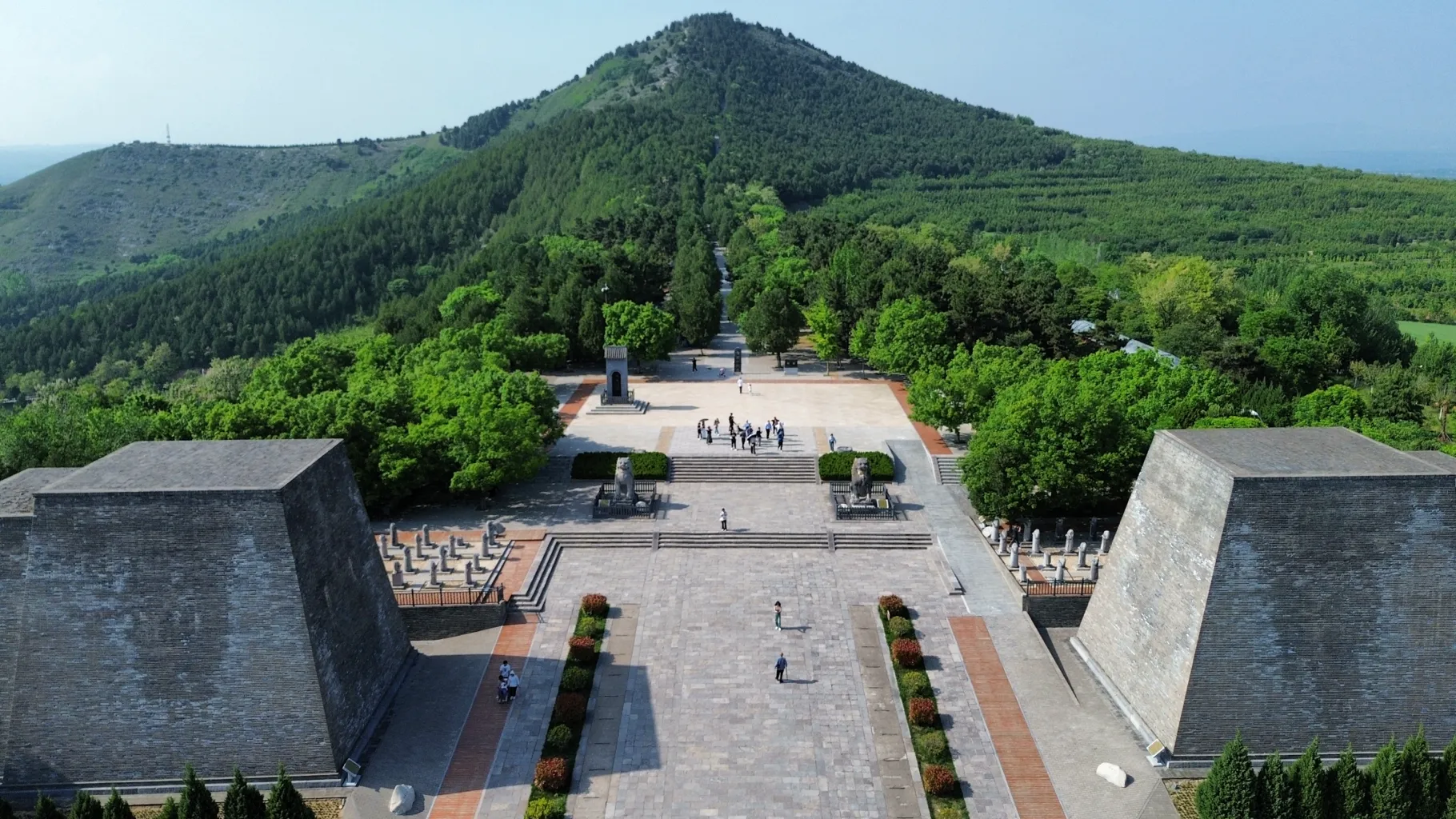
Construction and Historical Context
The construction of the Qianling Mausoleum began during the prosperous early years of the Tang Dynasty, reflecting the era’s strong national power. The mausoleum’s design mimics the layout of Chang’an, the Tang capital, and includes a palace, an imperial city, and an external contour city. The construction spanned the reigns of Empress Wu Zetian, Emperor Zhongzong, and the early period of Emperor Ruizong, lasting a total of 57 years.
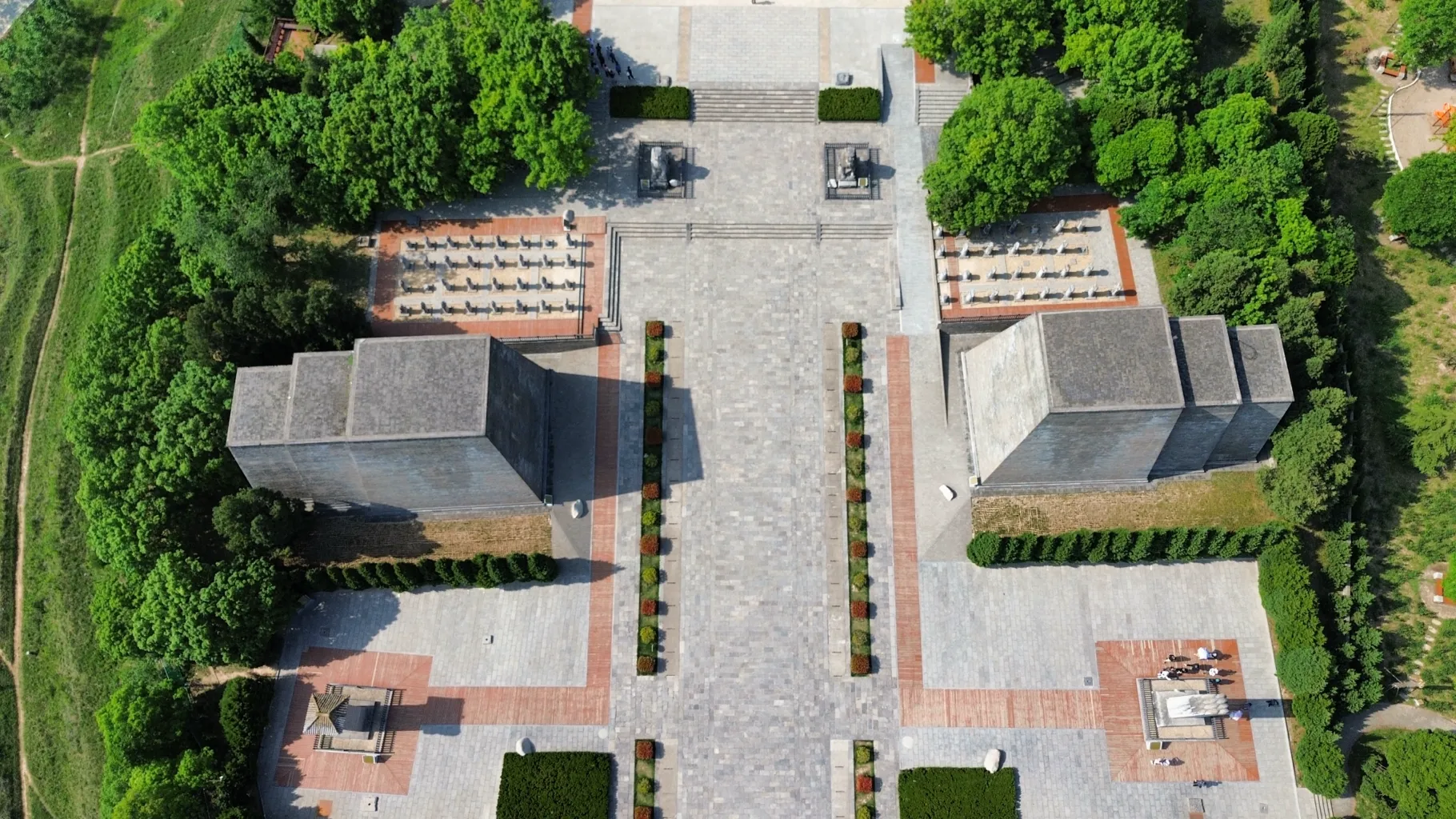
Cultural and Archaeological Treasures
Despite the loss of its original surface structures, the Qianling Mausoleum still houses significant cultural artifacts. These include the Palace Xian, Shangxian Taoist Temple, and the Portrait Ancestral Hall of Sixty Courtiers, among others. Notably, the mausoleum features an impressive collection of stone statues, which were unprecedented at the time of their creation. These statues include more than 120 figures, such as ornamental pillars, winged horses, and various symbolic animals, arranged symmetrically along the Sima Avenue outside the Zhuque Gate.
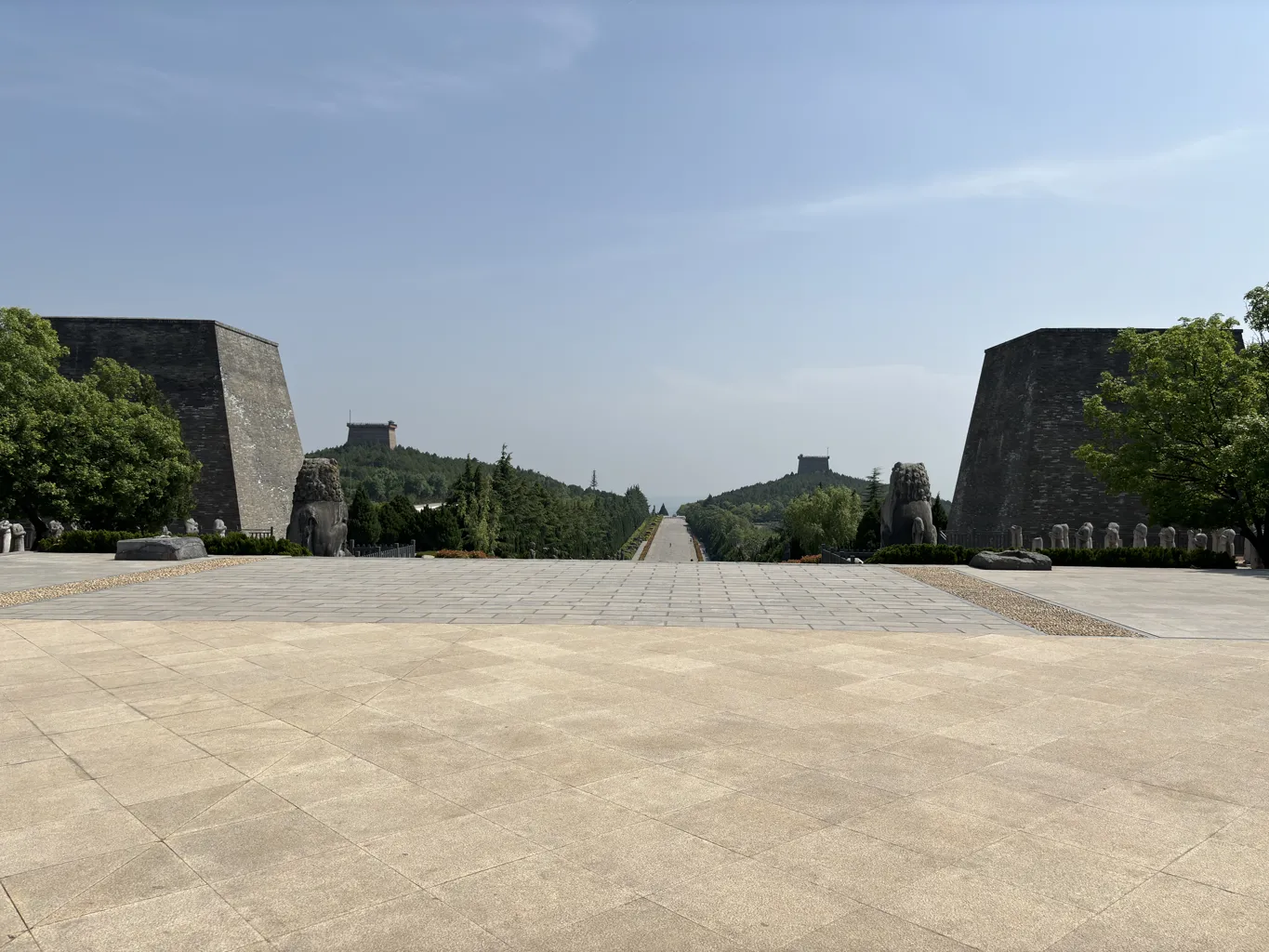
Subordinate Tombs and Accessibility
The mausoleum complex also includes several subordinate tombs, where imperial family members and court officials are interred. Notable among these are the tombs of Princess Yongtai, Prince Zhanghuai, and Prince Yide. These tombs have been excavated and are open to the public, allowing both Chinese and international visitors to explore them throughout the year.
The Qianling Mausoleum not only serves as a resting place for historical figures but also as a testament to the architectural and cultural achievements of the Tang Dynasty. Its strategic location and grand design continue to draw interest and admiration from around the world.

Historical Significance of Stone Ostriches
Ostriches, originating from Africa and West Asia, served as tributes during the Han Dynasty from Persia. This practice highlighted the diplomatic exchanges of the era. Moreover, the tradition continued into the Tang Dynasty. For instance, a stone ostrich stands prominently in front of an imperial tomb, mirroring the placement at the Qianling tomb. This symbolizes the deep-rooted friendship between China and the nations of Africa and West Asia.
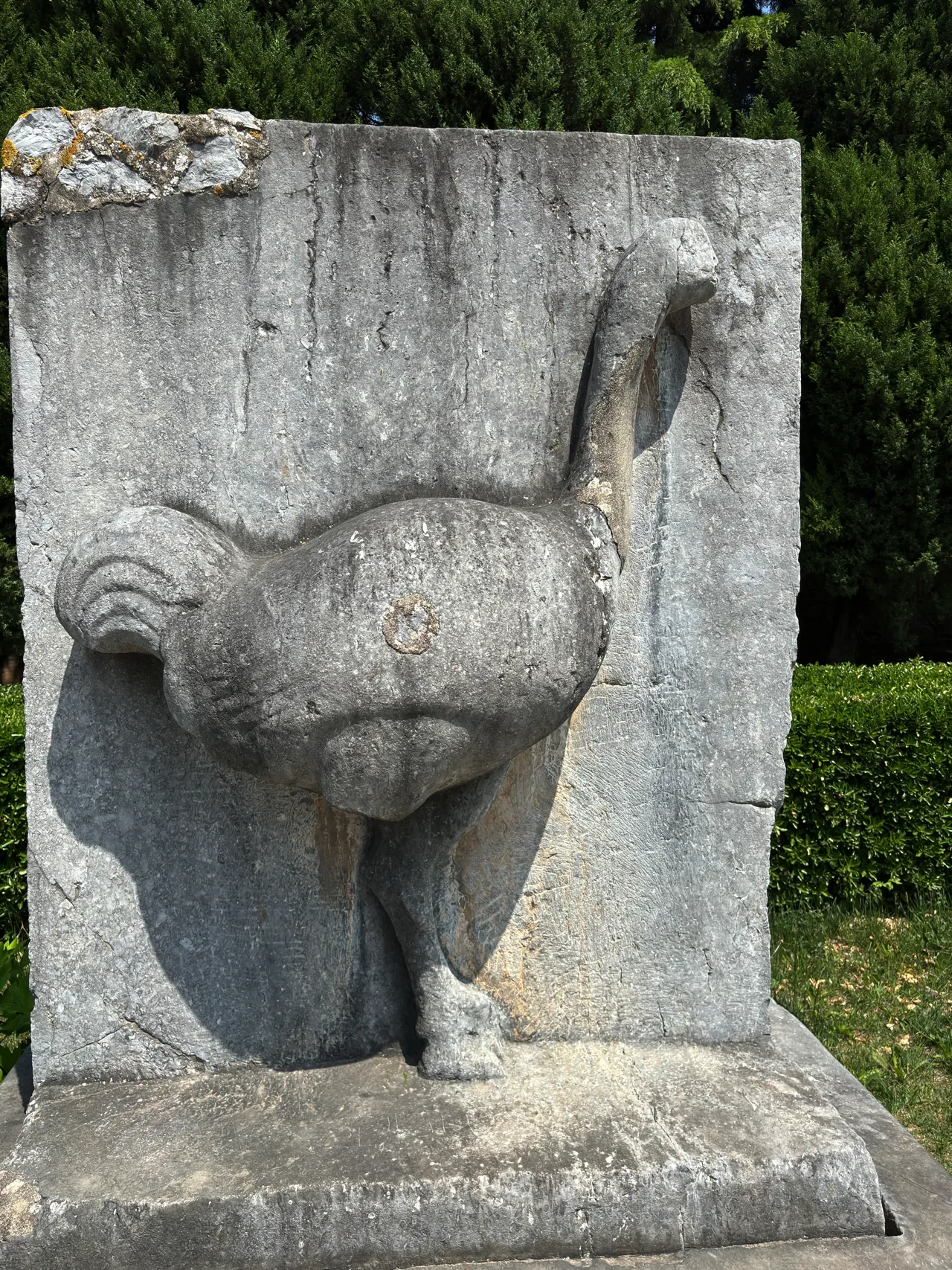
The stone ostriches measure between 1.73 and 1.76 meters in height and 1.32 to 1.38 meters in width. Their thickness ranges from 0.40 to 0.42 meter. Artisans carved each ostrich into a rectangular stone screen. They skillfully achieved a hollow and plastic effect, showcasing their remarkable craftsmanship. This artistic approach not only captures the physical attributes of the ostriches but also enhances their symbolic significance in Sino-African and West Asian relations.
The Stone Guard General Statues
General Ruan Wengzhong, famously known as Weng Zhong, served under Emperor Qin Shi Huang. The emperor assigned him to guard Lintao and combat the Xiongnu. To honor his service, a bronze statue of General Weng Zhong stands proudly outside the gate of Xian Yang Palace.
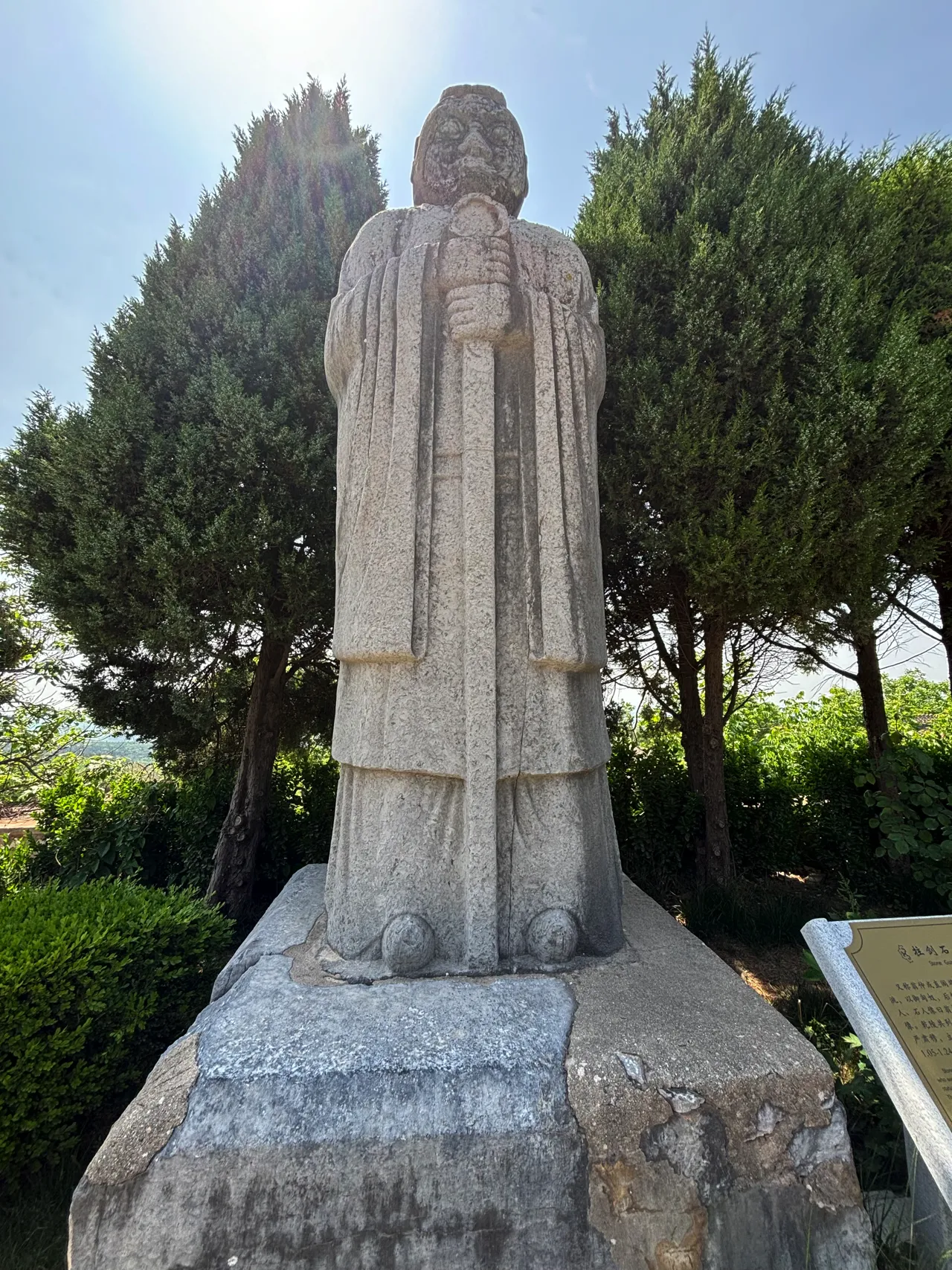
The statues, often referred to as the Stone Guard General, Bronze General, or simply Wengzhong, symbolize civil and military officials. They flank the Spirit Way, embodying respect and protection. These statues, ten pairs in total, showcase circular carvings. Each figure leans on a sword with a solemn expression, exuding authority and vigilance. The statues’ dimensions vary, with heights ranging from 3.75 to 4.16 meters, widths from 1.05 to 1.24 meters, and thicknesses from 0.64 to 0.90 meters. This setup not only commemorates historical figures but also enhances the ceremonial pathway’s grandeur.
The Gate Towers
Gate towers, strategically positioned in front of palaces or tombs, serve both defensive and symbolic purposes. Initially, builders constructed these towers on piers and abutments for protection. Over time, they evolved to signify the stature of the individual who commissioned them.
Gate towers fall into two categories: side towers and corner towers. Typically, the most esteemed individuals receive a three-leveled gate tower. For instance, a pair of these imposing three-leveled structures flanks each of the four gates at the Qian Ling tomb.
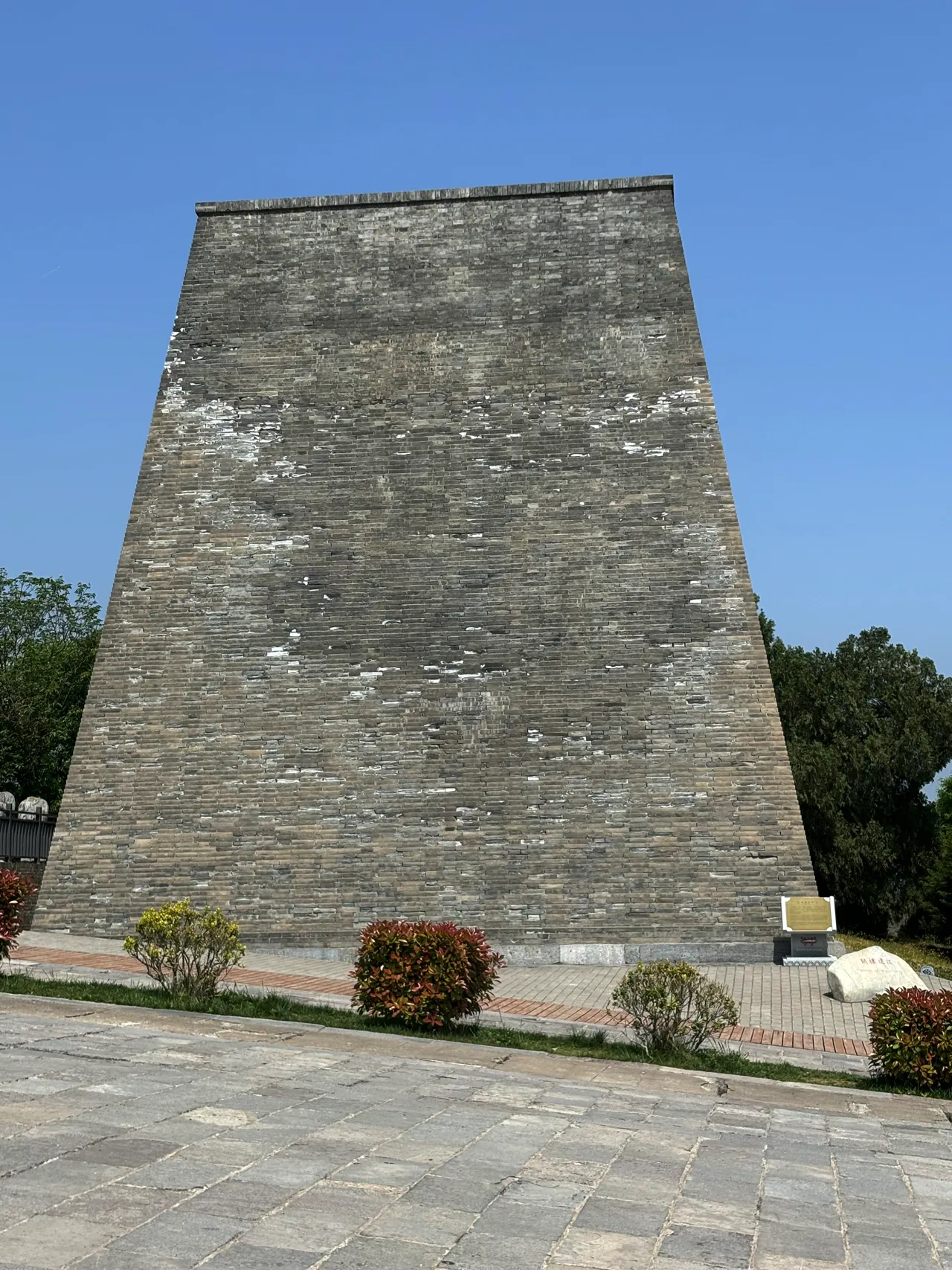
Moreover, gate towers are not limited to external defenses. They also appear at the four inner gate corners, enhancing the security and grandeur of the outer gates and satellite tombs. This strategic placement underscores their importance in ancient architectural design, blending functionality with status representation.
Symbolic Representation of Tang Dynasty Diplomacy
The 61 Statues of Foreign Diplomats stand as a testament to the Tang Dynasty’s expansive diplomatic relations. These statues originally celebrated the allegiance of various troops and countries to Emperor Gao Zong and Empress Wu Zetian. Initially, each statue prominently displayed details such as the county and troop names, titles, ranks of nobility, and personal names. However, these inscriptions have faded and are no longer legible.
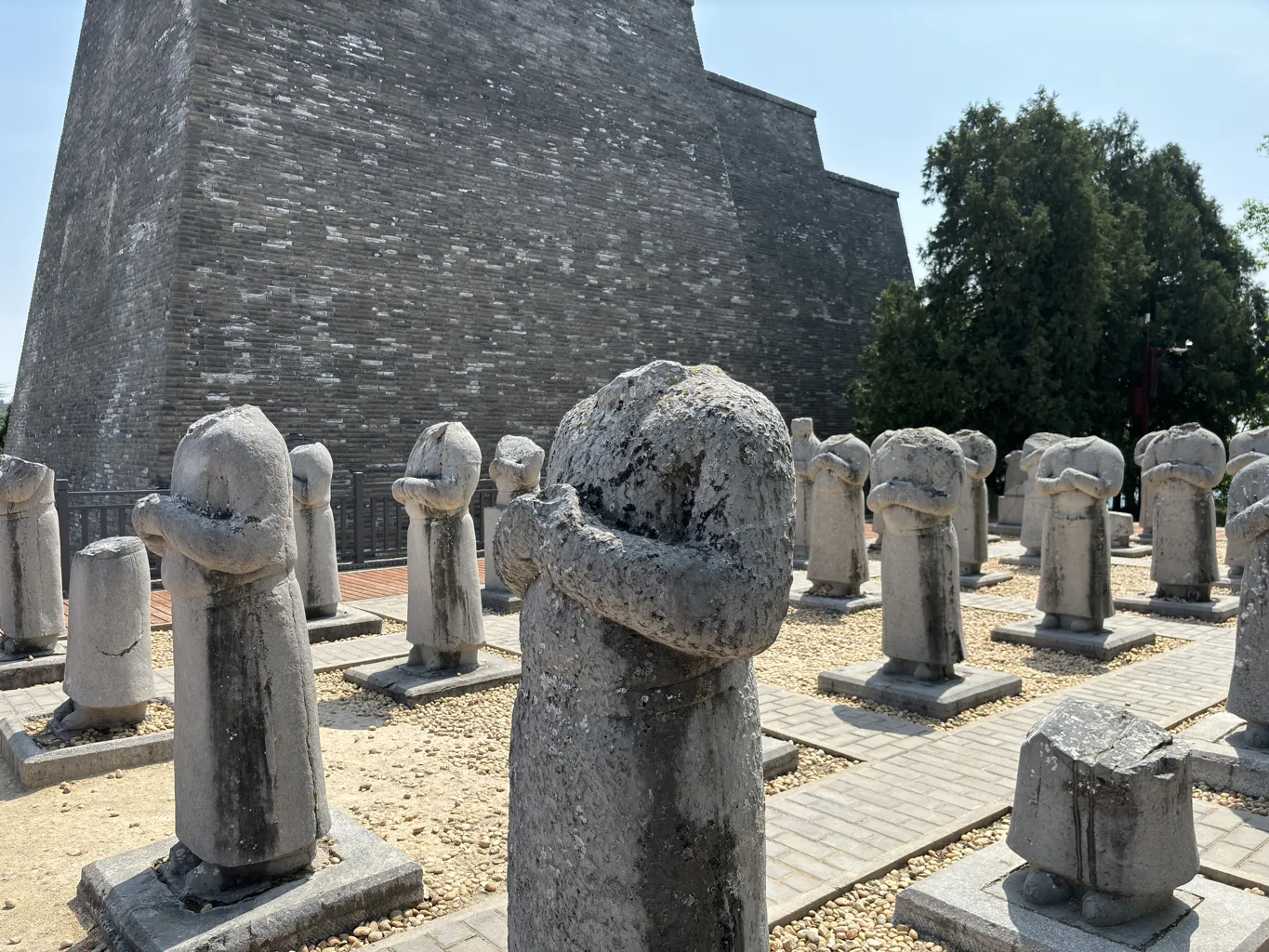
Originally, there were 64 statues, but only 61 remain today. Craftsmen carved these figures from blue stone in a circular formation. Despite their current headless state, the statues still impress with heights ranging from 1.50 to 1.77 meters and shoulder widths between 0.54 and 0.65 meters. These remnants poignantly underscore the once-flourishing connections between the Tang Dynasty and its neighbors.
Historical Significance of the Stone Lion
Lions, originating from Africa and West Asia, symbolized tribute during the Han Dynasty. These majestic creatures represented the deep bonds between China and the nations of Africa and West Asia. Specifically, artisans crafted four pairs of stone lions, placing them strategically outside the four inner city gates. This placement underscores the significance of these relationships in historical and diplomatic contexts.
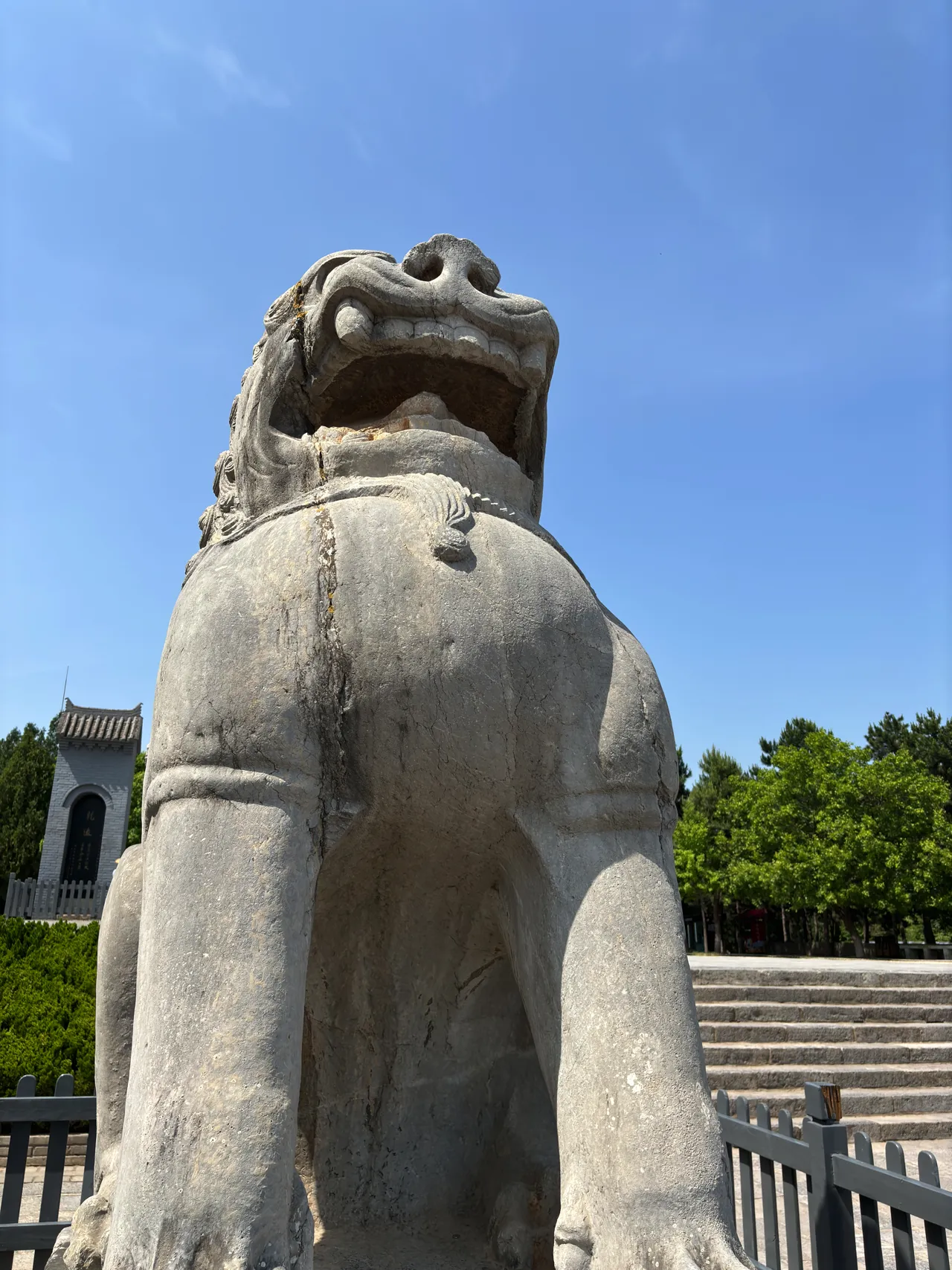
The stone lion outside the south gate of the Qianling Tomb showcases exquisite craftsmanship. Carvers used bluestone to create this impressive sculpture through circular carving techniques. The lion stands 3.02 meters tall, measures 2.32 meters in length, and spans 1.40 meters in width. This imposing figure not only serves as a guardian but also as a testament to the artistic prowess of the era.
Introduction to the Uncharactered Tablet
The Uncharactered Tablet, erected during the early Tang Dynasty, stands out due to its blank surface. Empress Wu Zetian commissioned this unique monument, and its purpose has intrigued scholars for centuries. Crafted from a single boulder, the tablet’s dimensions are impressive. It measures 6.54 meters in height, 2.10 meters in width, and 1.49 meters in thickness.
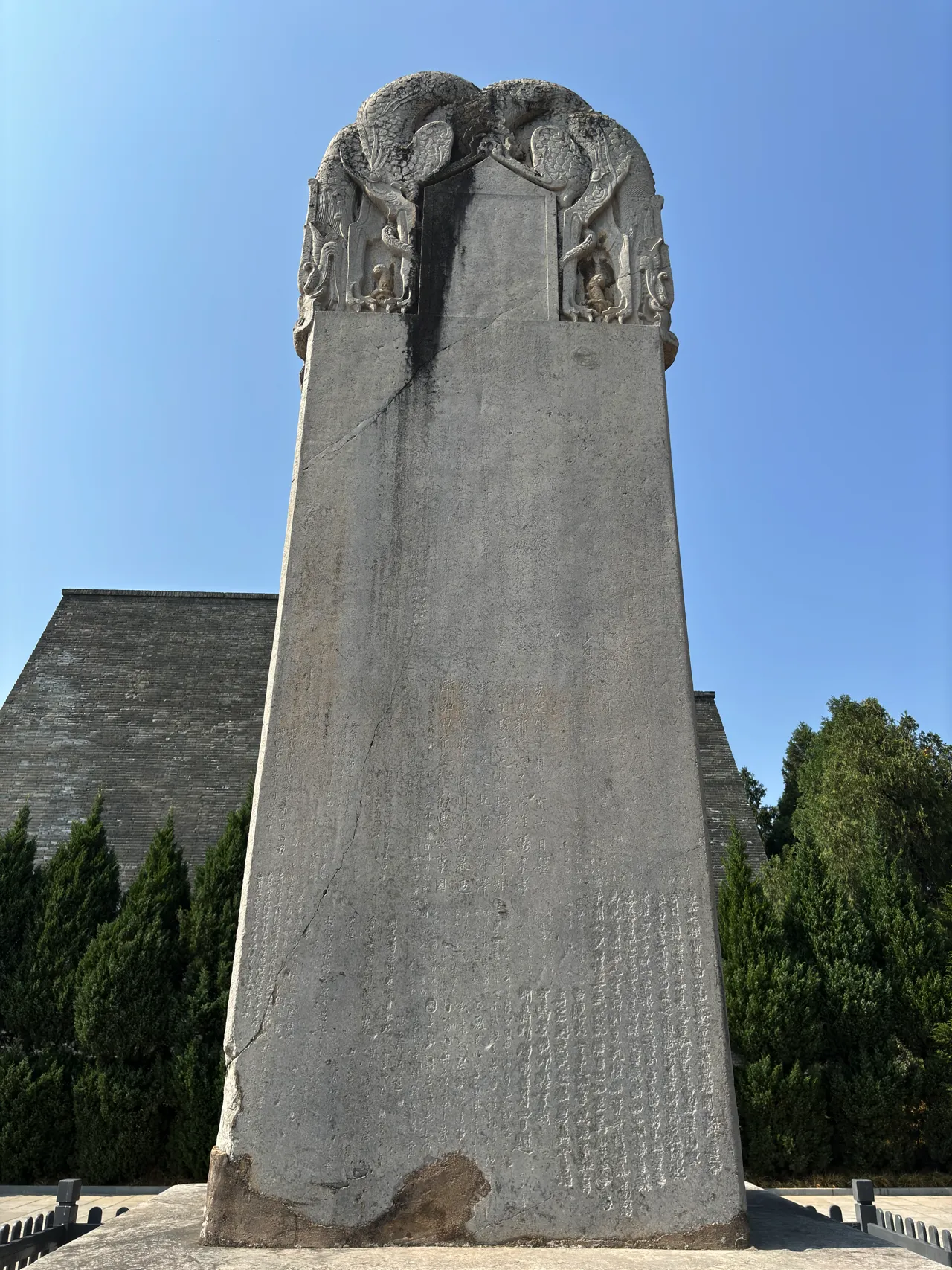
Furthermore, the base of the tablet extends 3.37 meters in length, 2.61 meters in width, and 1.49 meters in height. Consequently, the entire structure, including its base, reaches a height of 8.03 meters and weighs approximately 98.8 tons. Artisans intricately carved eight twined chi longs, or dragon-like creatures, at the tablet’s head. Additionally, they engraved dragon clouds and auspicious animals on both sides of the tablet and all four sides of the base.
Remarkably, no one inscribed any poems or characters on the Uncharactered Tablet until the Song and Jin Dynasties. This delay in marking the tablet adds to its mystique and historical value, prompting ongoing research and speculation about its original intent and significance.
The Golden Age of the Tang Dynasty
The Tang Dynasty marks the greatest golden age in Chinese history. During this era, China experienced an unprecedented level of openness to the outside world. This period saw ethnic integration and an economic boom that fueled cultural prosperity. Social interactions were incredibly active, attracting foreign envoys and merchants. Moreover, Confucianism, Buddhism, and Taoism flourished simultaneously. The arts, including poetry, painting, sculpture, calligraphy, music, dance, crafts, and architecture, all underwent significant qualitative leaps.
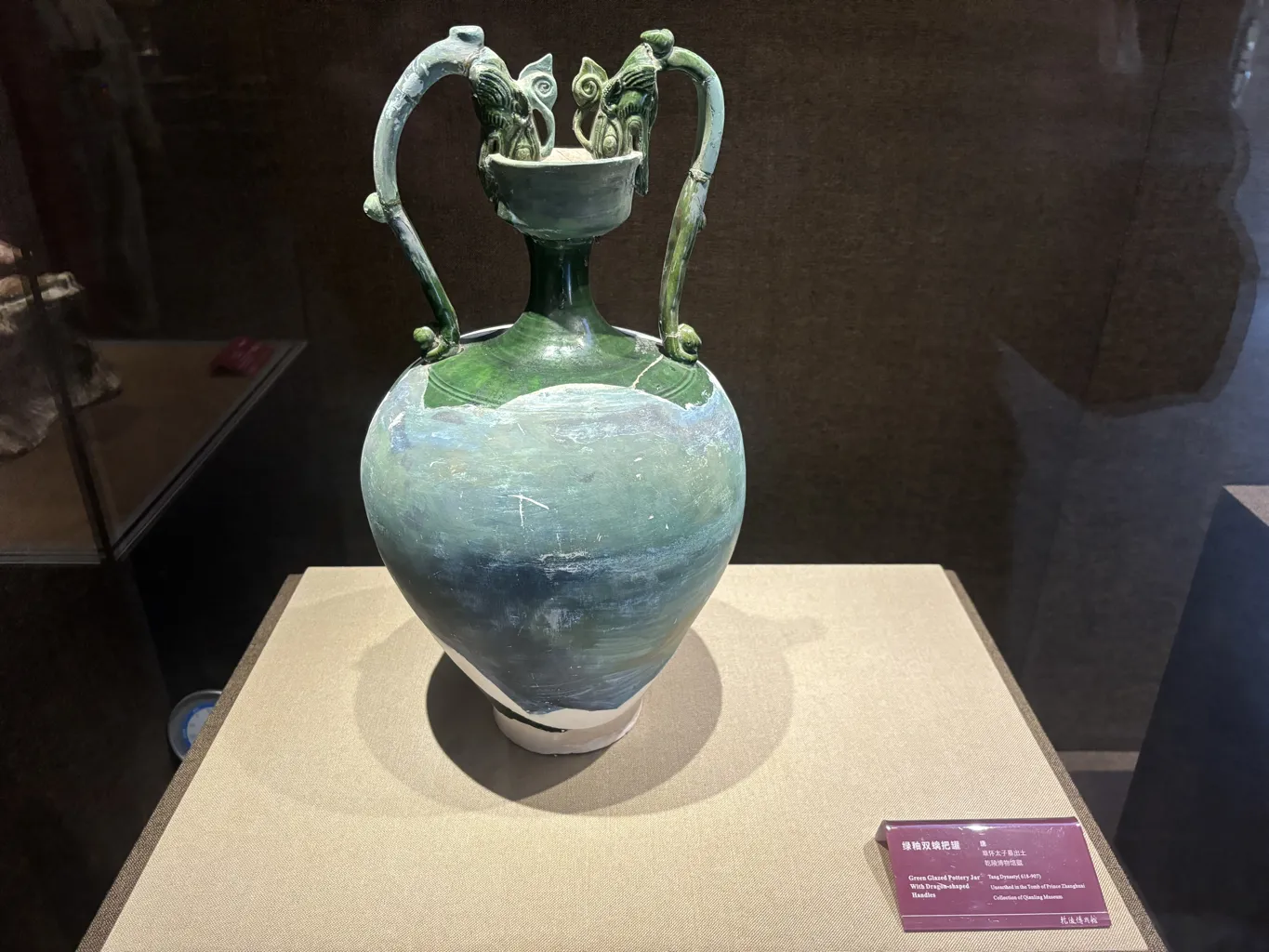
Exploring Tang Dynasty’s Cultural Relics
The “Dream Back to the Tang Dynasty” exhibition at the Qianling Museum showcases 100 fine cultural relics. These include tri-colored pottery figures, gold and silver wares, and line carving pictures from stone coffins. Additionally, visitors can admire murals from Tang dynasty tombs. This exhibition allows us to witness the splendor and glory of Tang culture from various perspectives, offering a unique cultural journey through time.
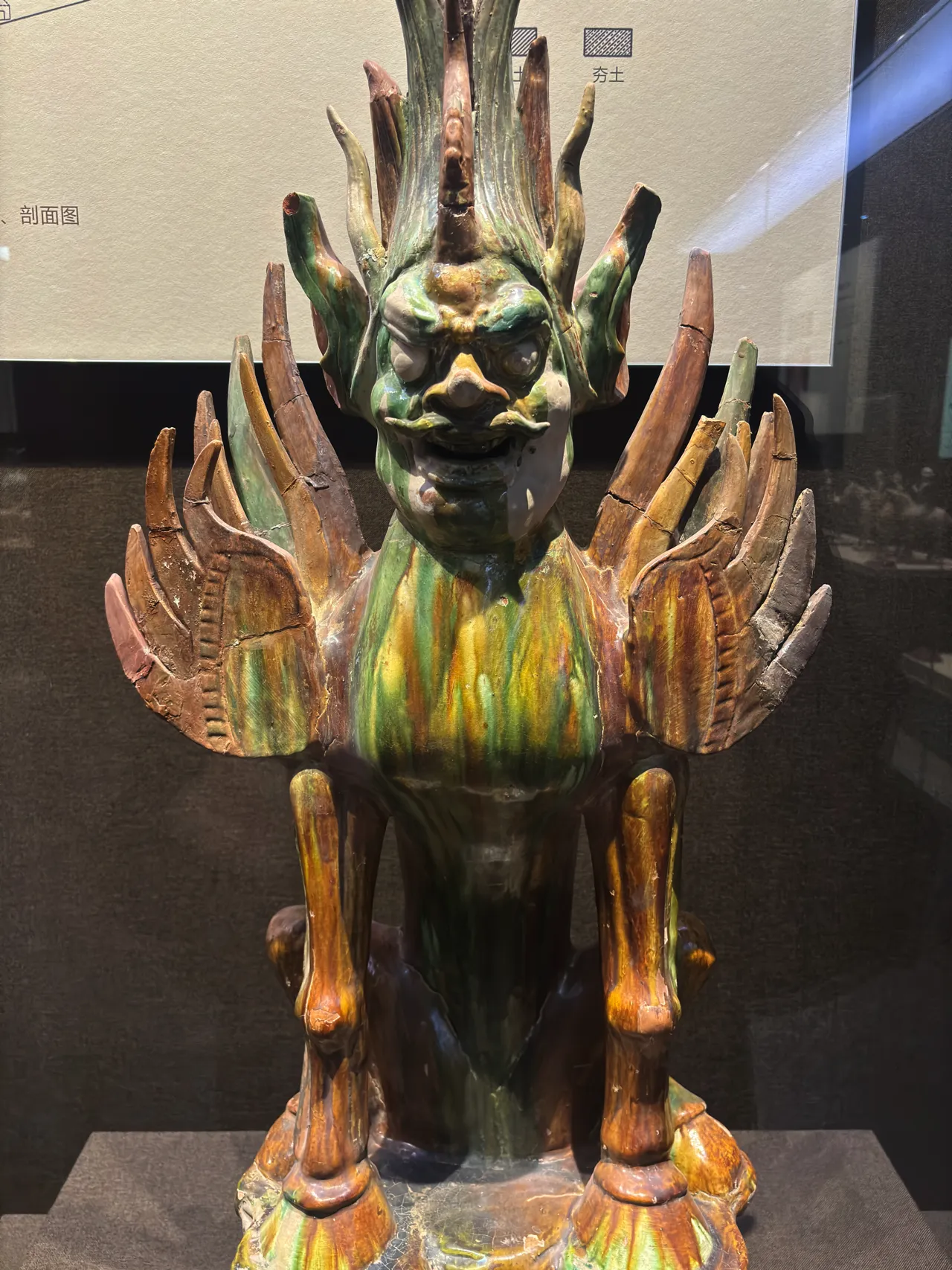
Tri-colored pottery from the Tang Dynasty features a vibrant polychrome glaze. Artisans fired these ceramics at low temperatures, ranging from 800 to 1100°C. The predominant hues of yellow, white, and green define this pottery, although red, blue, and brown also appear. These colors contribute to the pottery’s worldwide acclaim.
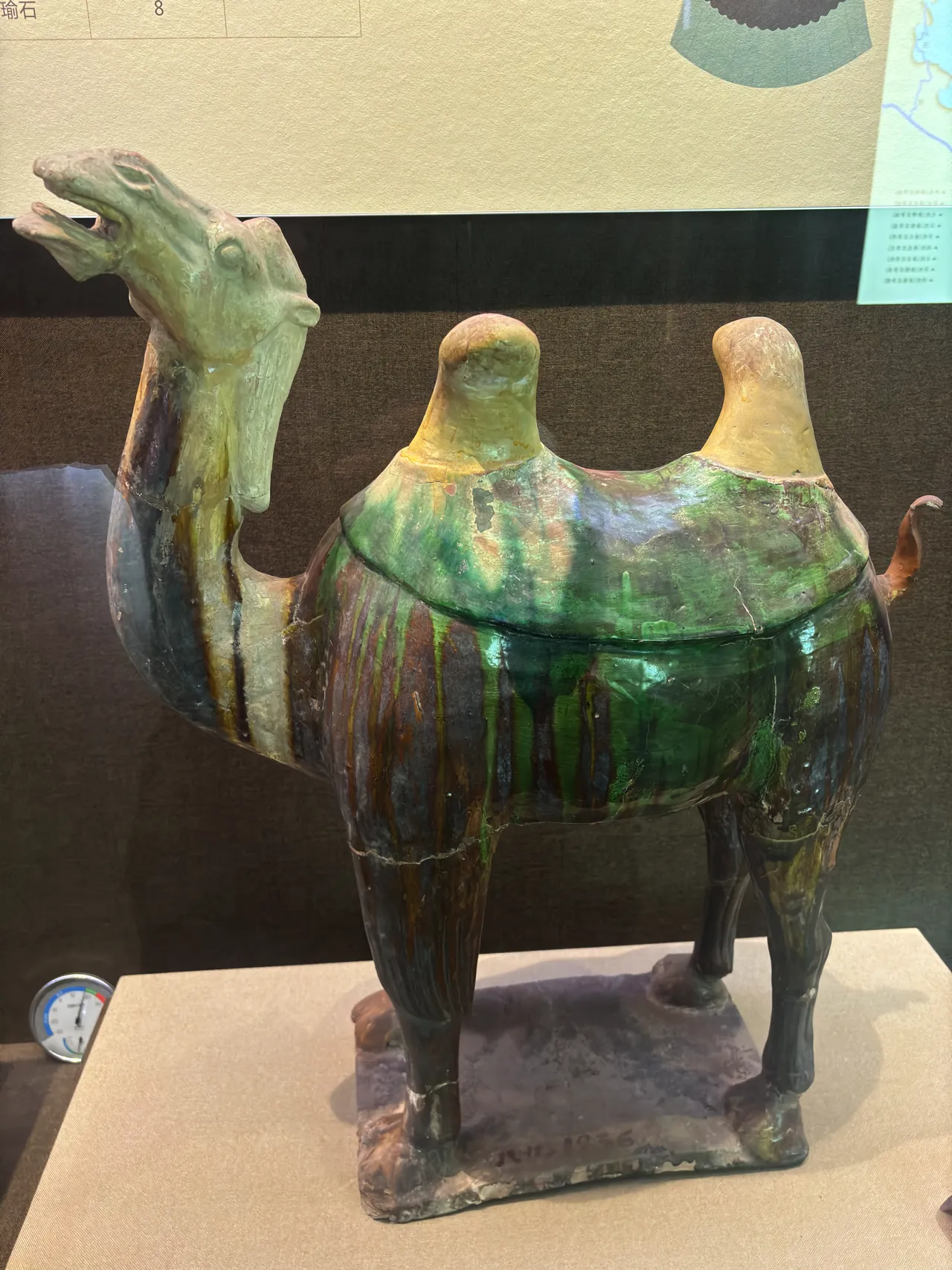
Artistic Significance and Global Reach
The Tang Dynasty’s tri-colored pottery is renowned for its artistic design and vivid colors. Particularly, the pieces excavated from the satellite tombs of the Qianling Mausoleum represent the zenith of this craft. These artifacts are notable for their variety, large size, and bright colors, making them the most celebrated examples.
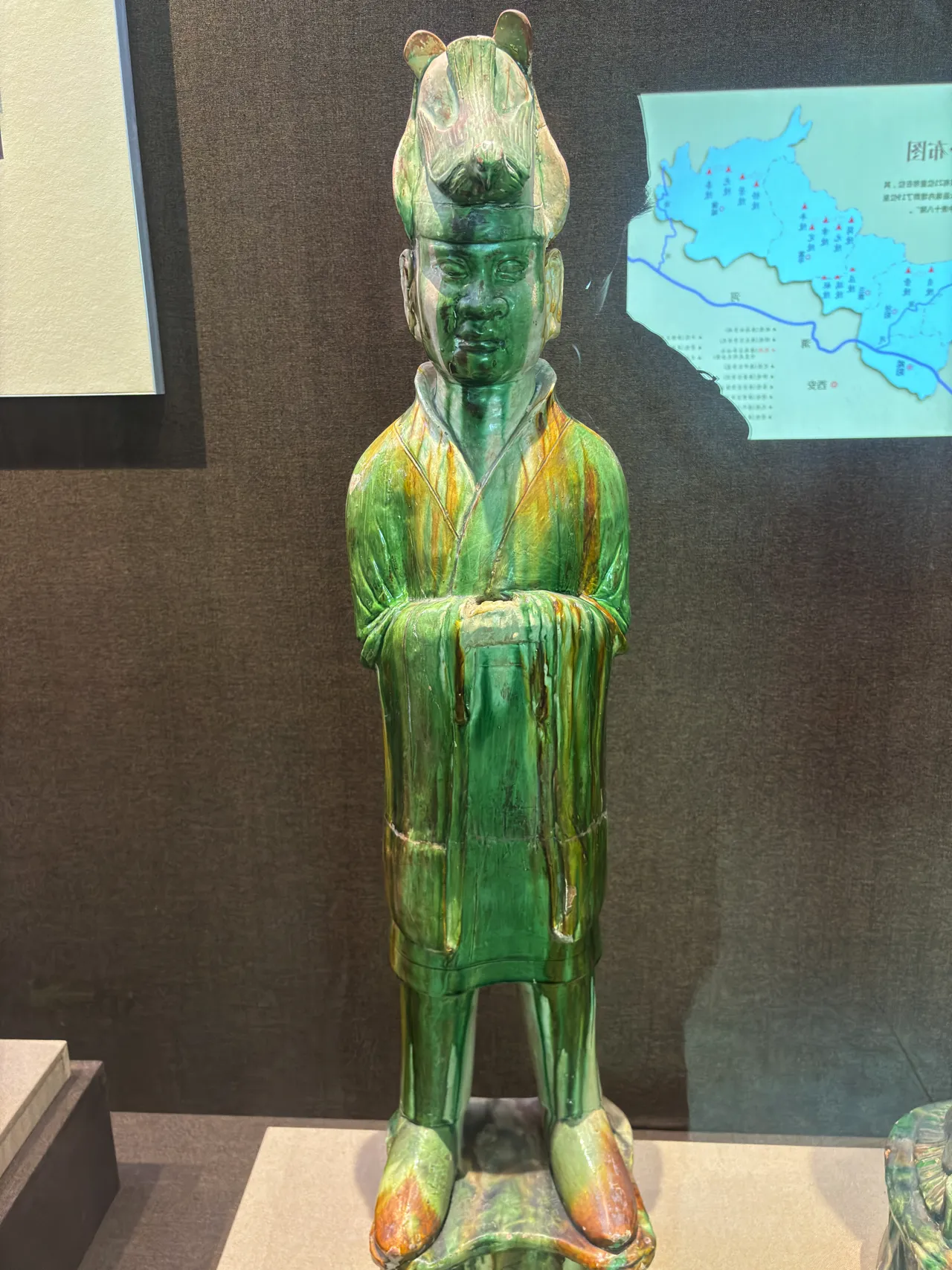
Moreover, this pottery was not only popular in China but also reached international markets. Countries such as India, Iran, Iraq, Egypt, Italy, and Korea have unearthed these exquisite pieces, attesting to their widespread appeal and historical significance in trade and cultural exchange.
Ancient Chinese Stone Coffins: The Guo
In ancient China, a stone coffin known as “guo” served a crucial role. Craftsmen designed these coffins to protect the wooden coffin inside. Moreover, they tailored the guo to reflect the deceased’s social status. This practice highlights the deep respect for hierarchy and tradition in ancient Chinese society.
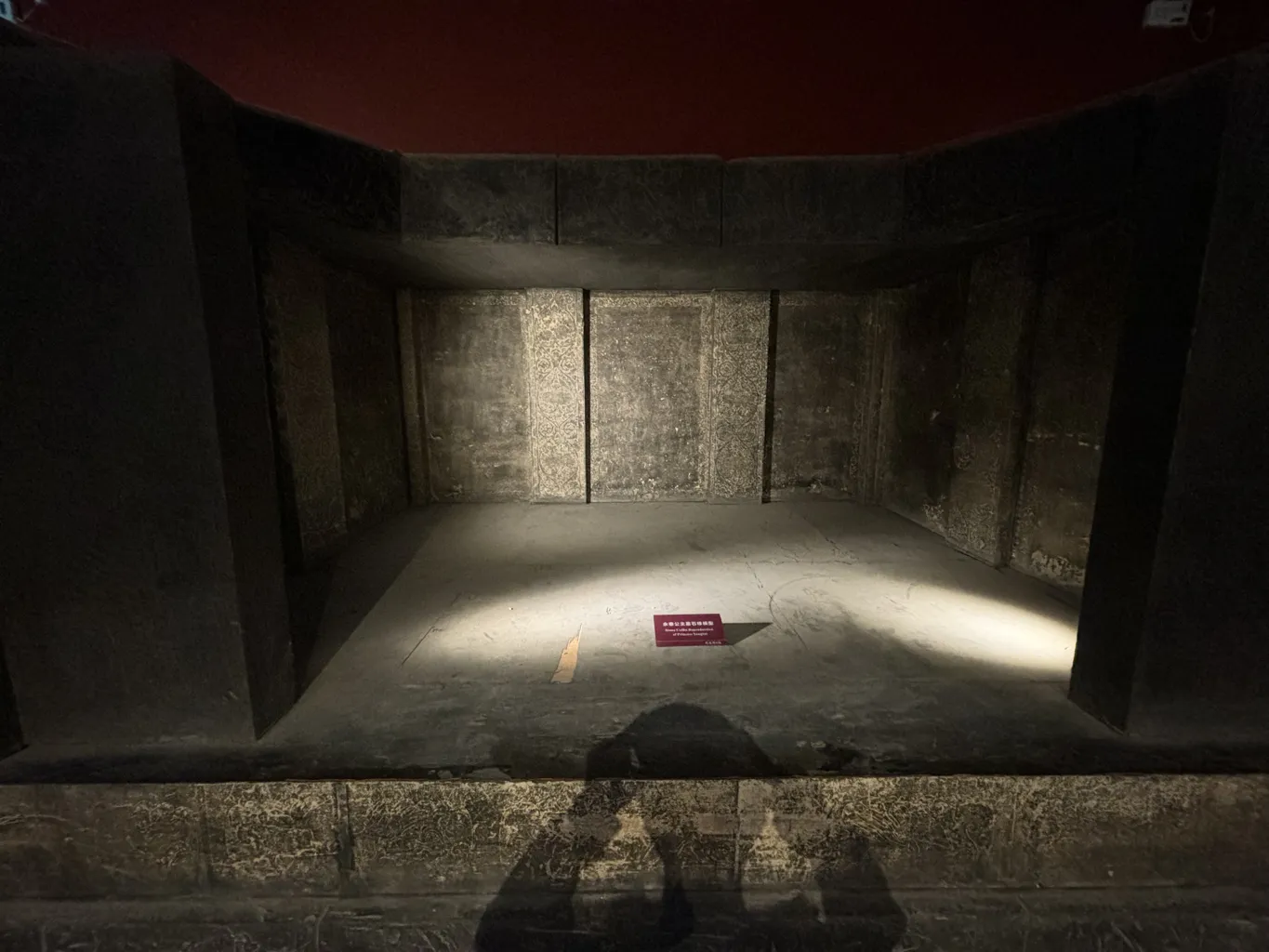
Artistry in Stone: Linear Engraving
Linear engraving on stone represents a unique art form from ancient China. Artisans skillfully cut graceful and detailed lines into stone surfaces. Notably, the Qianling Mausoleum area has yielded various artifacts with linear engraving. These include outer coffins, stone doors, epitaphs, tablets, and foundation bases. Such engravings not only served decorative purposes but also conveyed cultural and historical narratives.
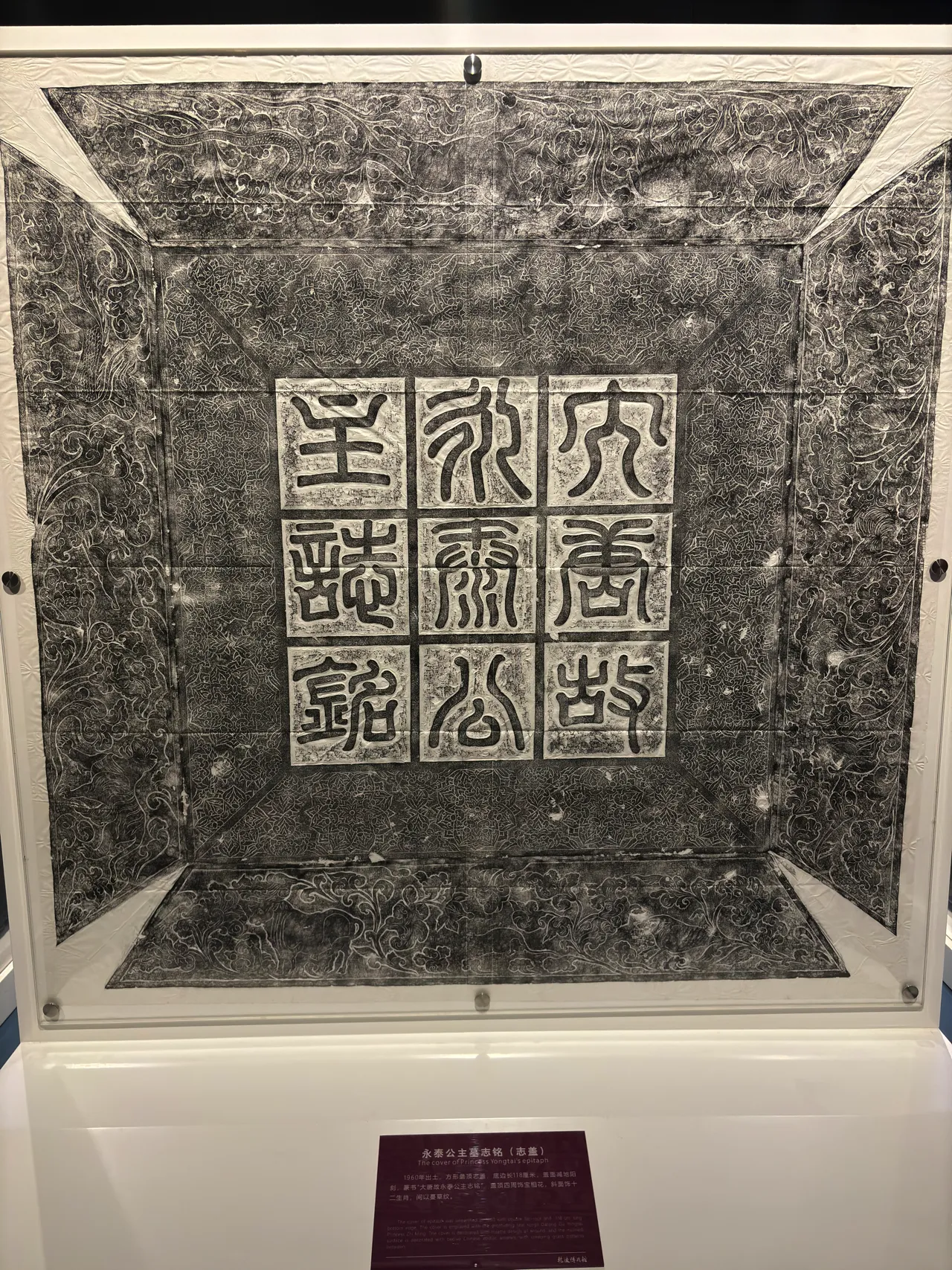
The Guo of Princess Yongtai
The guo found on the west side of Princess Yongtai’s tomb’s rear chamber is particularly remarkable. Composed of 34 pieces of dark jade, it weighs approximately 39 tons. Measuring three bays in width, it stands as the largest guo discovered in China to date. The sides of this monumental piece feature elegant carvings of human figures, flowers, and birds. Additionally, scenes of imperial palace life enhance its historical value, making it a rare example of large-scale stone carving.
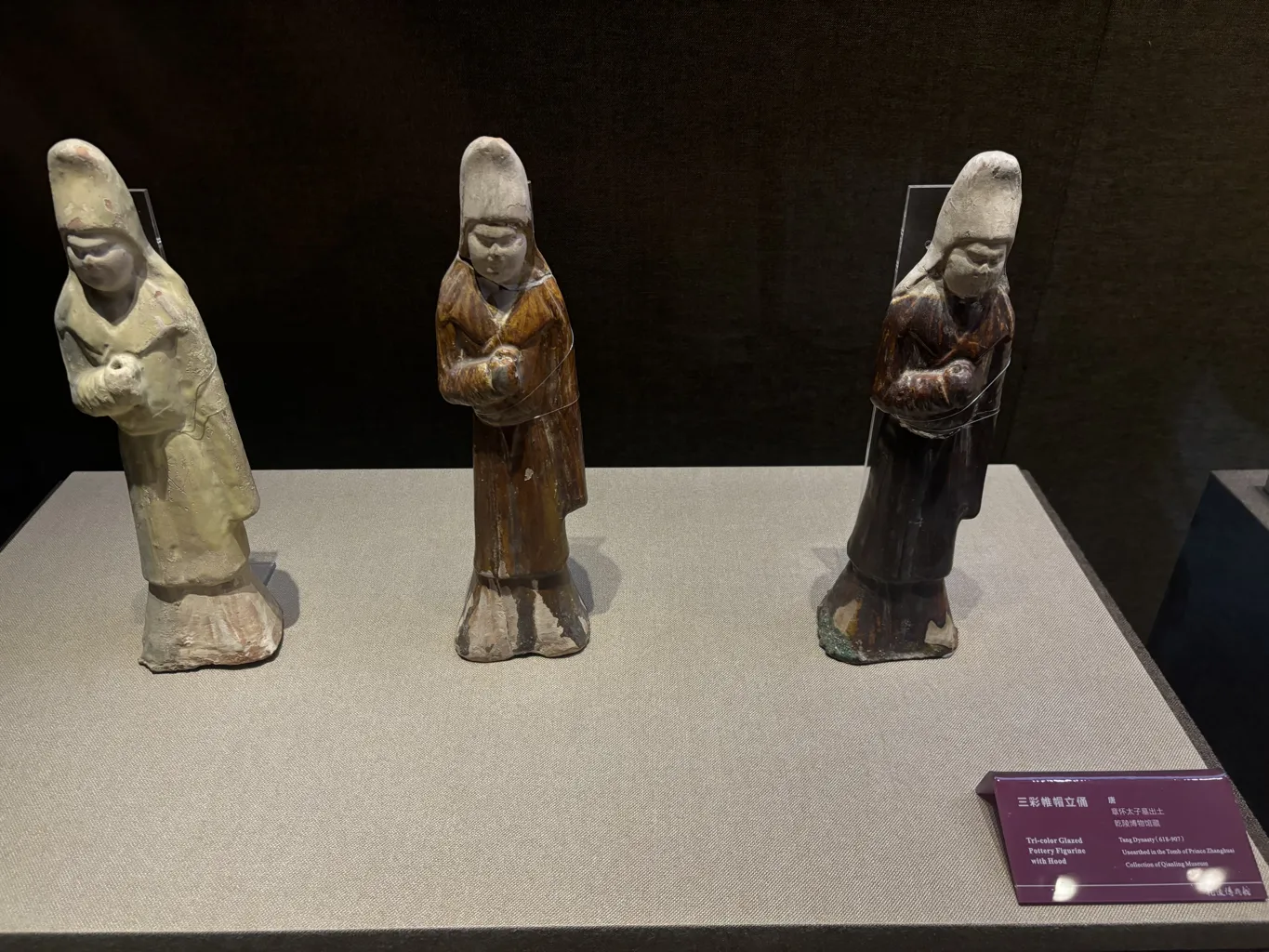
Precious Discoveries at Qianling Mausoleum
The satellite tombs of Qianling Mausoleum have yielded various artifacts, albeit in smaller quantities due to historical tomb raiding. These findings primarily include gold and silver ornaments such as gilded bronze door knockers, locks, trappings, and gold flower petals. Other notable discoveries are bronze mirrors, iron stirrups, locks, painted wood figurines, and jade plaques inscribed with the tomb owner’s life story. Among these, a bronze mirror inscribed with the phrase “as smooth as still water” stands out. This mirror, from the Tang Dynasty, showcases exceptional craftsmanship, classic ornamental patterns, and a shining silver color, marking it as a highlight of the era’s artistic achievement.
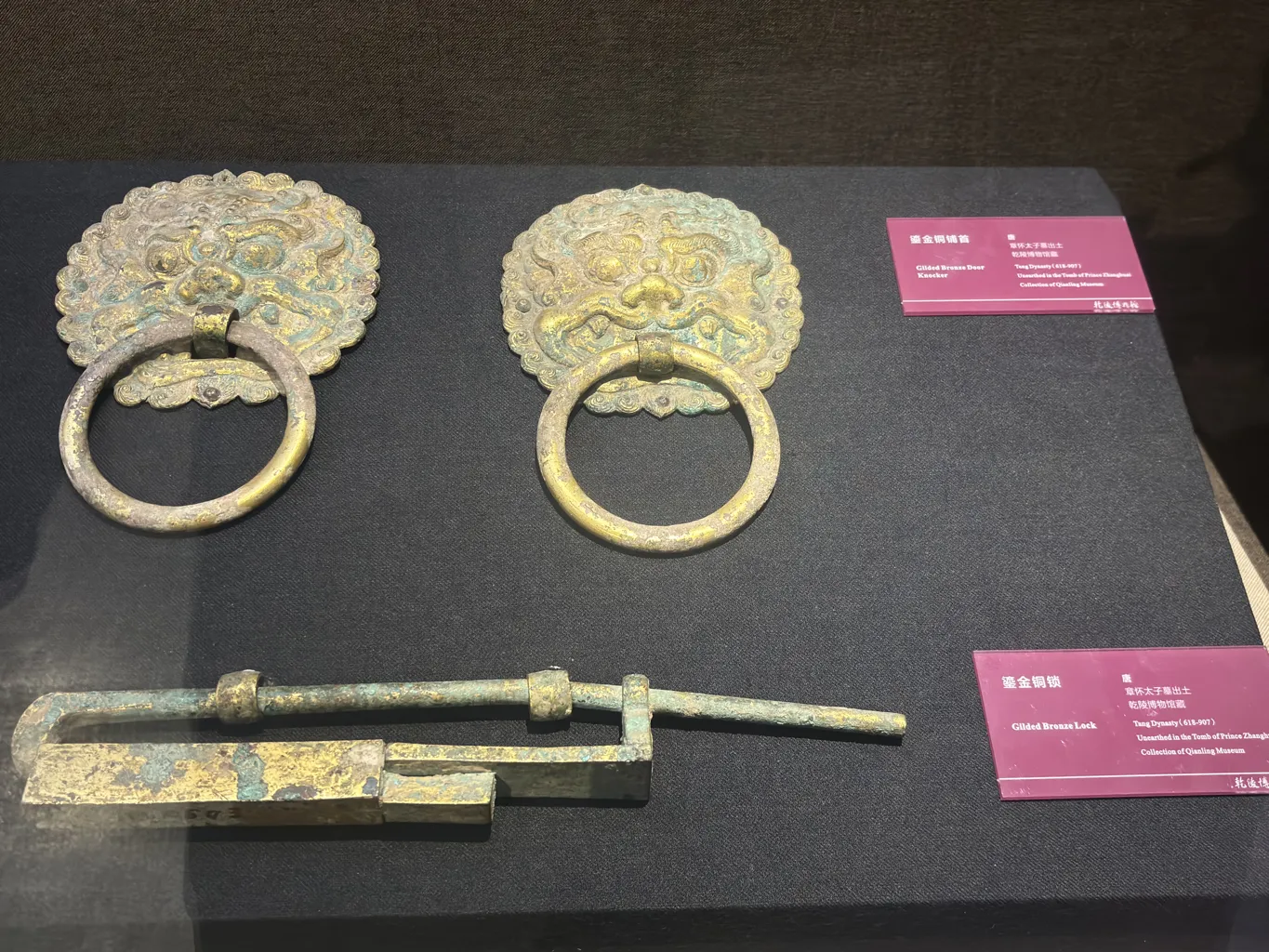
Painted Pottery Wares: A Study in Color and Craftsmanship
Painted pottery wares originate from plain clay, which artisans transform with colors and patterns after firing in a kiln. These wares vary widely in category and style. The colors on the pottery figurines are particularly expressive, vividly reflecting the personality and detailed clothing of each figure. This expressive use of color renders the figurines lifelike and showcases their artistic craftsmanship. Among these, the most prized are the gold-overlaid pottery wares. These pieces catch the eye with their brilliant colors and superior workmanship, earning their status as the pinnacle of painted pottery. The finest examples, including those depicting armored cavalrymen, palace maids, and warriors, have been unearthed from the satellite tombs of the Qianling Mausoleum.
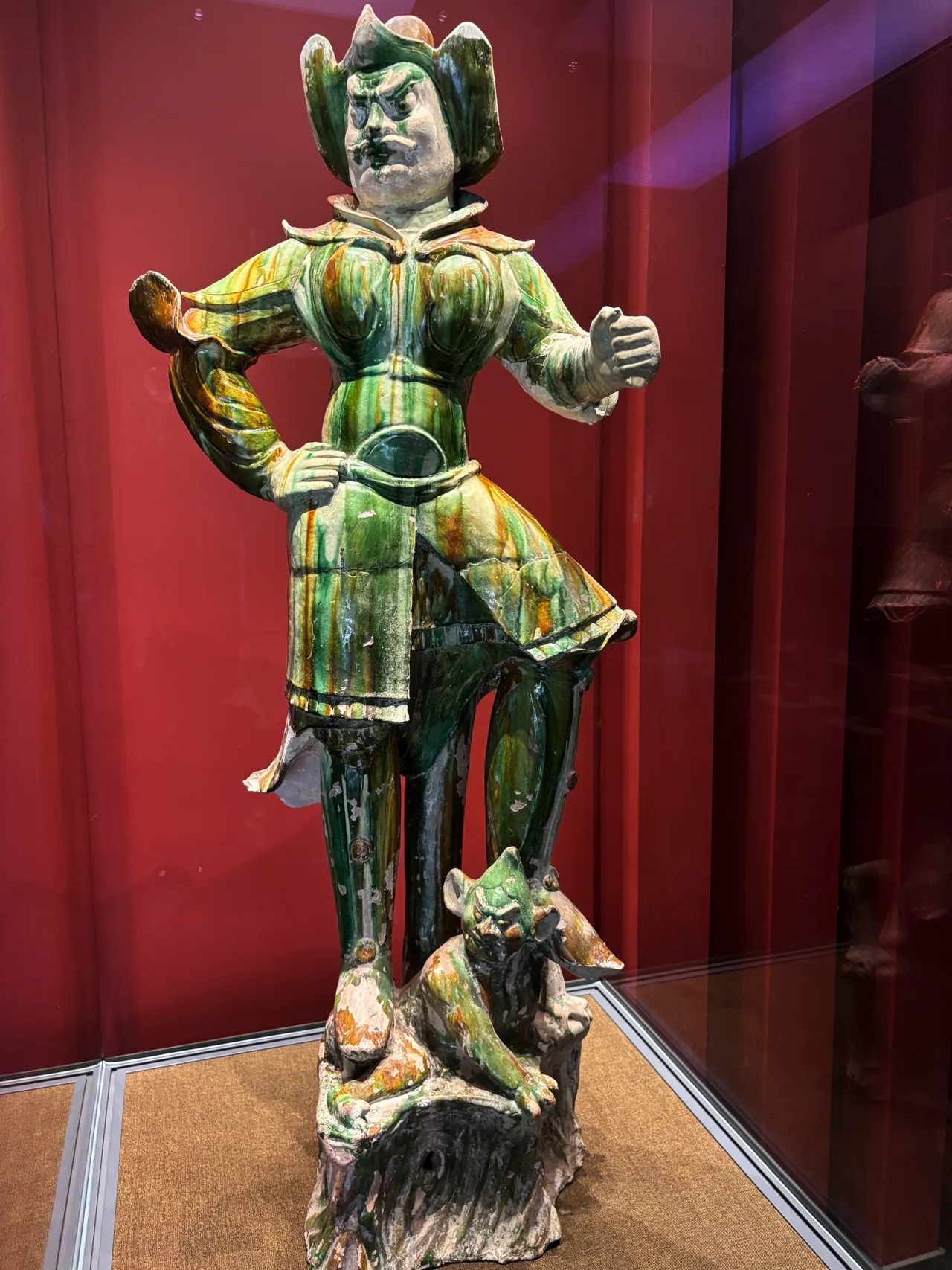
The Evolution and Significance of Mural Painting in Chinese History
Mural painting holds a significant place in Chinese historical art forms. The murals from the satellite tombs of the Qianling Mausoleum are renowned for their high quality, large scale, and the breadth of their themes. These artworks cover a wide array of subjects and exhibit exquisite craftsmanship. During the Tang Dynasty, notable advancements in mural painting techniques, scale, and thematic richness marked a significant evolution in this art form. The murals served not only as burial decorations but also as mediums to express ideas about life and death. They stand as historical witnesses to the era’s events and are considered a unique phenomenon in the history of ancient Chinese art. Famous murals such as “Palace Maids,” “Polo Match,” and “Hunting Expedition” distinctly embody Tang Dynasty features and are revered as national treasures.
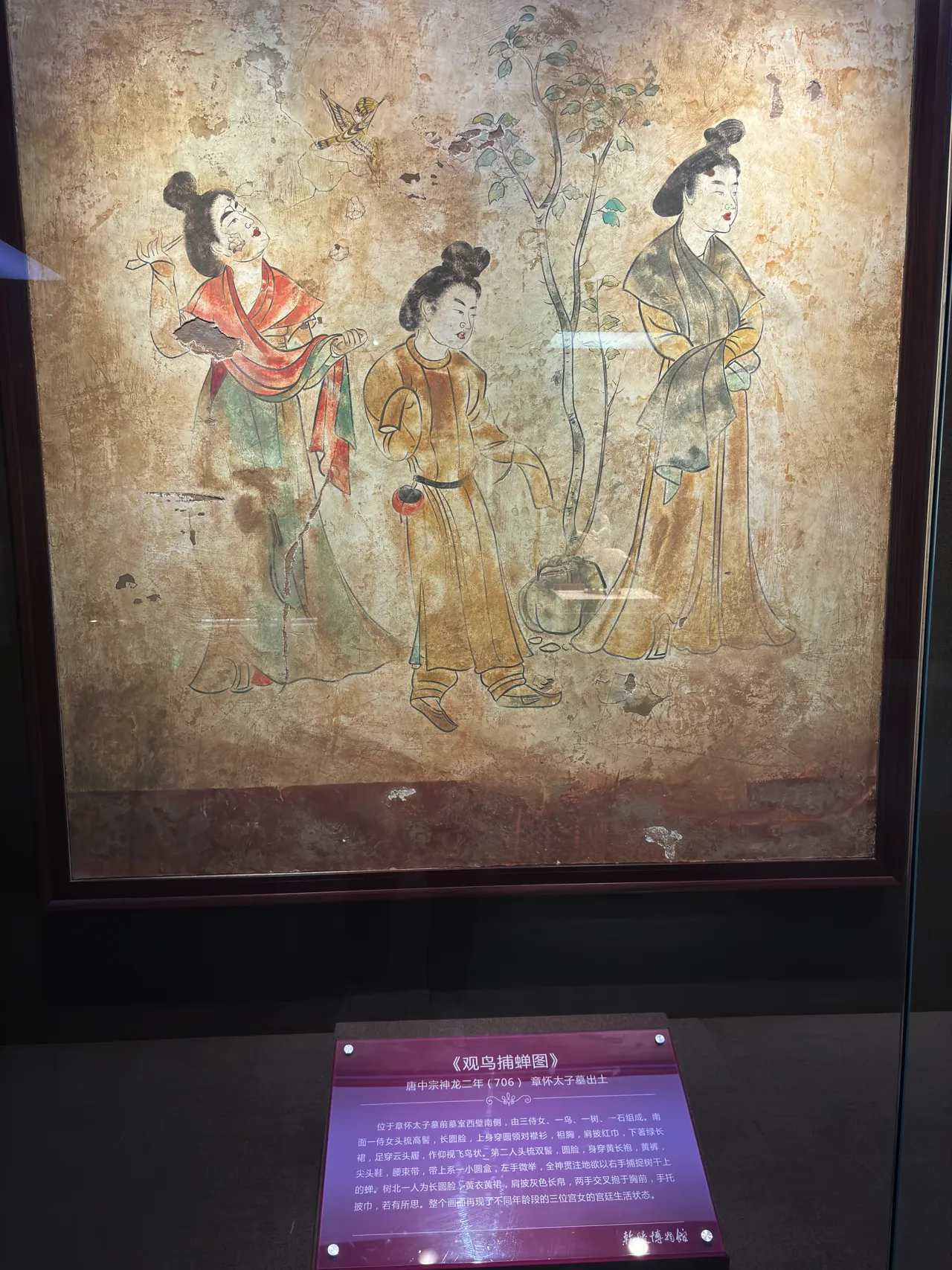
Sources: Information directly from a visit at Qianling Mausoleum
Read also:

